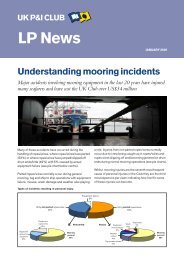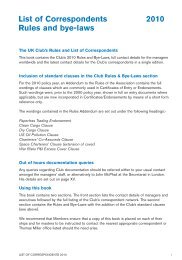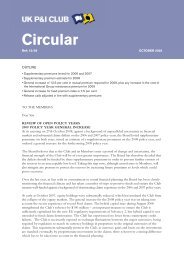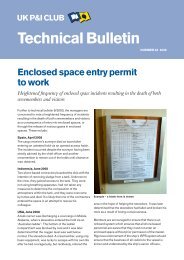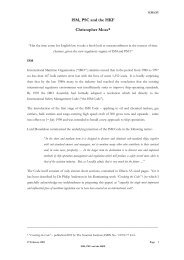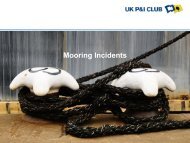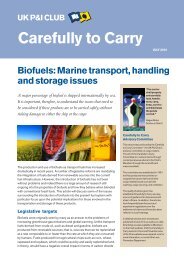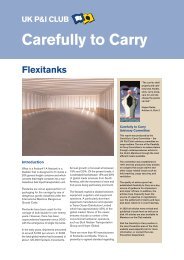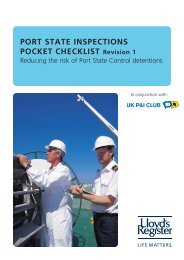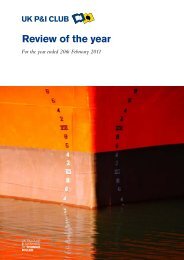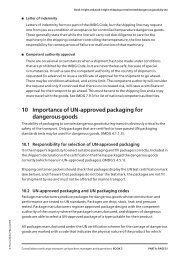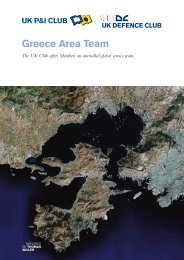Bulk Matters - UK P&I
Bulk Matters - UK P&I
Bulk Matters - UK P&I
Create successful ePaper yourself
Turn your PDF publications into a flip-book with our unique Google optimized e-Paper software.
Hold cleaning –<br />
preparing a ship<br />
for grain<br />
Surveyors inspection/<br />
requirements<br />
Prior to loading grain, all ships are usually subject to a<br />
survey by an approved independent surveyor. The<br />
surveyor will require the vessels particulars and details<br />
of at least the last three cargoes carried. He will then<br />
inspect the holds for cleanliness and infestation, or the<br />
presence of any material which could lead to infestation.<br />
When the surveyor is satisfied with the condition of the<br />
hold, he will issue the ship with a certificate stating<br />
which holds are fit to load grain.<br />
Purpose:<br />
To ensure cargo holds are prepared to receive<br />
the next cargo.<br />
Large claims have arisen when cargo holds have not<br />
been cleaned sufficiently to prevent cargo contamination.<br />
The requirements for cleaning the holds are dependent<br />
upon the previous cargo carried, the next cargo to be<br />
carried, charterers’ requirements, the requirements of<br />
shippers and/or the authorities at the port of loading and<br />
the receivers.<br />
It is becoming common practice for receivers to have an<br />
inspector at the load port.<br />
General<br />
Regardless of the previous cargo, all holds should be<br />
thoroughly cleaned by sweeping, scraping and highpressure<br />
sea water washing to remove all previous cargo<br />
residues and any loose scale or paint, paying particular<br />
attention to any that may be trapped behind beams,<br />
ledges, pipe guards, or other fittings in the holds.<br />
Cargo hold: coal sticking and discharging salt<br />
If the ship has been carrying DRI (direct reduced iron),<br />
the dust created by this particular cargo during loading<br />
or discharging, will be carried to all areas of the ships<br />
structure and the reaction between iron, oxygen and<br />
salt will create an aggressive effect wherever the dust<br />
may settle. This is particularly noticeable on painted<br />
superstructures. (The IMO <strong>Bulk</strong> Cargo Code contains<br />
guidelines).<br />
Whenever salt water washing is used to clean hatches,<br />
the relevant holds should always be rinsed with fresh<br />
water to minimise the effects of corrosion and to<br />
prevent salt contamination of future cargoes. In this<br />
respect, arrangements should be made in good time to<br />
ensure sufficient fresh water is available for this<br />
operation.<br />
Before undertaking a fresh water rinse, the supply line<br />
(normally the deck fire main or similar) will need to be<br />
flushed through to remove any residual salt water.<br />
Accordingly, it is suggested that fresh water rinsing of<br />
the holds is left until the end of hold cleaning operations<br />
to minimise the amount of fresh water required.<br />
Grain preparation and safe<br />
carriage<br />
One of the most difficult hold cleaning tasks is to<br />
prepare a ship for a grain cargo after discharging a dirty<br />
or dusty cargo such as coal or iron ore, particularly if<br />
the last cargo has left ‘oily’ stains on the paintwork or<br />
other deposits stubbornly adhering to the steel<br />
surfaces. Greasy deposits which remain on the<br />
bulkheads will require a ‘degreasing chemical wash’<br />
and a fresh water rinse in order to pass a grain<br />
inspection. The degreasing chemical used should be<br />
environmentally acceptable for marine use, and safe to<br />
apply by ships staff, who have had no special training<br />
and do not require any specialised protective<br />
equipment. Product safety data sheets of the chemical<br />
should be read, understood and followed by all persons<br />
involved with the environmentally friendly degreasing<br />
chemical.<br />
To avoid taint problems, fresh paint should not to be<br />
used in the holds or under the hatch lids at anytime<br />
during the hold preparation, unless there is sufficient<br />
time for the paint to cure and be free of odour as per the<br />
3




